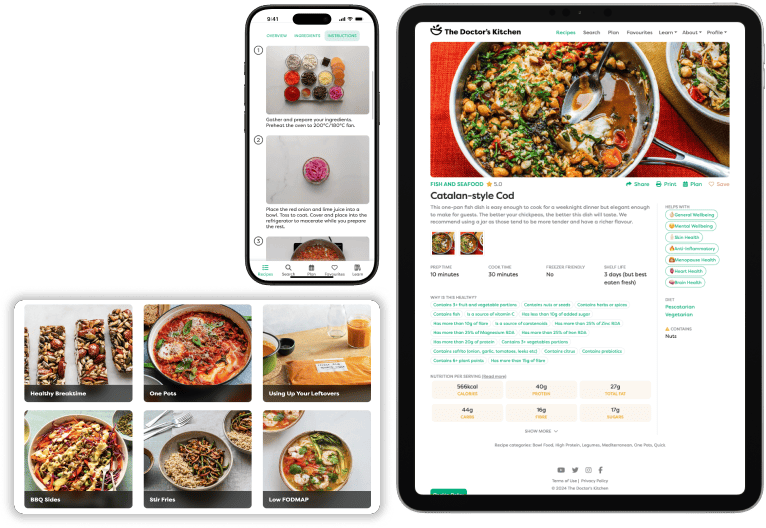Mushrooms: Vitamin D & immune support
8th Nov 2024
Mushrooms are a great addition to meals. They provide beta-glucans, vitamin D (if sun-exposed), protein and ergothioneine, a powerful antioxidant.
Key points
Health benefits
1. Cancer prevention
A higher intake of 18 g per day was linked to a lower risk of total cancer. We’re still figuring out which types of mushrooms are most effective or if these findings apply more widely.
2. Brain & mental health
Small studies suggest that people who eat more mushrooms may have a lower risk of depression and perform better on certain cognitive tests.
3. Unique nutrients
Mushrooms are not plants, so they offer unique compounds that you won’t find in many other foods.
Source of
- Ergothioneine – an amino acid with strong antioxidant properties, often called the ‘longevity vitamin’ for its potential to prevent or slow cellular damage.
- Dietary fibres, like β-glucans – which support gut health, help lower cholesterol and may improve immune function.
- Polyphenols such as carotenoids, with structures unique to fungi.
- High-quality protein – with good digestibility and a complete range of amino acids (particularly in button and king oyster mushrooms).
- Essential minerals like selenium, phosphorus, potassium and iron.
- Vitamins B12, C and D (when exposed to UV light)
A natural source of vitamin D
Just like us, mushrooms soak up the sun. They contain ergosterol in their cell walls, which converts into vitamin D2 when exposed to UV light. Common edible mushrooms like white buttons can produce up to 24 μg of vitamin D per 100g.
- Stable & cooking-friendly: They stay stable in the fridge for 7 to 10 days and cooking—like pan-frying without oil—retains up to 88% of their vitamin D2.
- Are they a good source? Vitamin D3 is considered more effective at increasing vitamin D levels but D2 from mushrooms can still make a meaningful difference, especially for people low on vitamin D, who get little sun or don’t eat animal products.
How much? Research suggests 4 portions of UV-exposed mushrooms a week for enough vitamin D, especially if you don’t get much sun or follow a vegan diet. One portion (80g) is about 3 handfuls of sliced mushrooms or roughly 14 button mushrooms.
How to enjoy
3 tips
- Choose UV-exposed: Look for labels like “UV-treated” or “Rich in vitamin D” at the shop.
- To wash or not? There’s a bit of debate since mushrooms can absorb water and lose texture. We think it’s fine to wash them, just do it right before cooking and pat them dry to get rid of excess moisture. You might need to cook them a bit longer to cook off any extra water.
- Remove any plastic: Store mushrooms in a paper bag or cardboard box to prevent sogginess and mould.
3 ways to enjoy
- Crispy side – Sauté them in a hot pan with olive oil and garlic until golden and crispy. Great with eggs, stews, pasta, fish, or even tossed into salads.
- Ragu & stews – Mushrooms bring a rich umami flavour, making your dishes feel more filling and satisfying. They’re a great way to cut back on meat, too. Chop or grate mushrooms into minced meat to reduce saturated fat, stretch your meal, and add extra fibre and nutrients.
- Stir fries with your favourite vegetables, a flavourful sauce and tofu, tempeh or fish.
If you’re not a fan (yet), experiment with cooking methods as they can massively change the texture and taste of mushrooms. Roasting can bring out their natural sweetness, while grilling adds a smoky flavour. Find a method that appeals to you!
References/sources
Compounds: Assemie et al. International Journal of Microbiology. 2022
Cancer prevention: Ba et al. Adv Nutr. 2021. PMID: 33724299 – Li et al. PLoS One. 2014. PMID: 24691133
Cognitive Health: Feng et al. J Alzheimers Dis. 2019. PMID: 30775990 - Zhang et al. J Am Geriatr Soc. 2017. PMID: 28295137.
Mental Health: Ba et al. Journal of Affective Disorders. 2021
- Access over 800 research backed recipes
- Personalise food for your unique health needs
